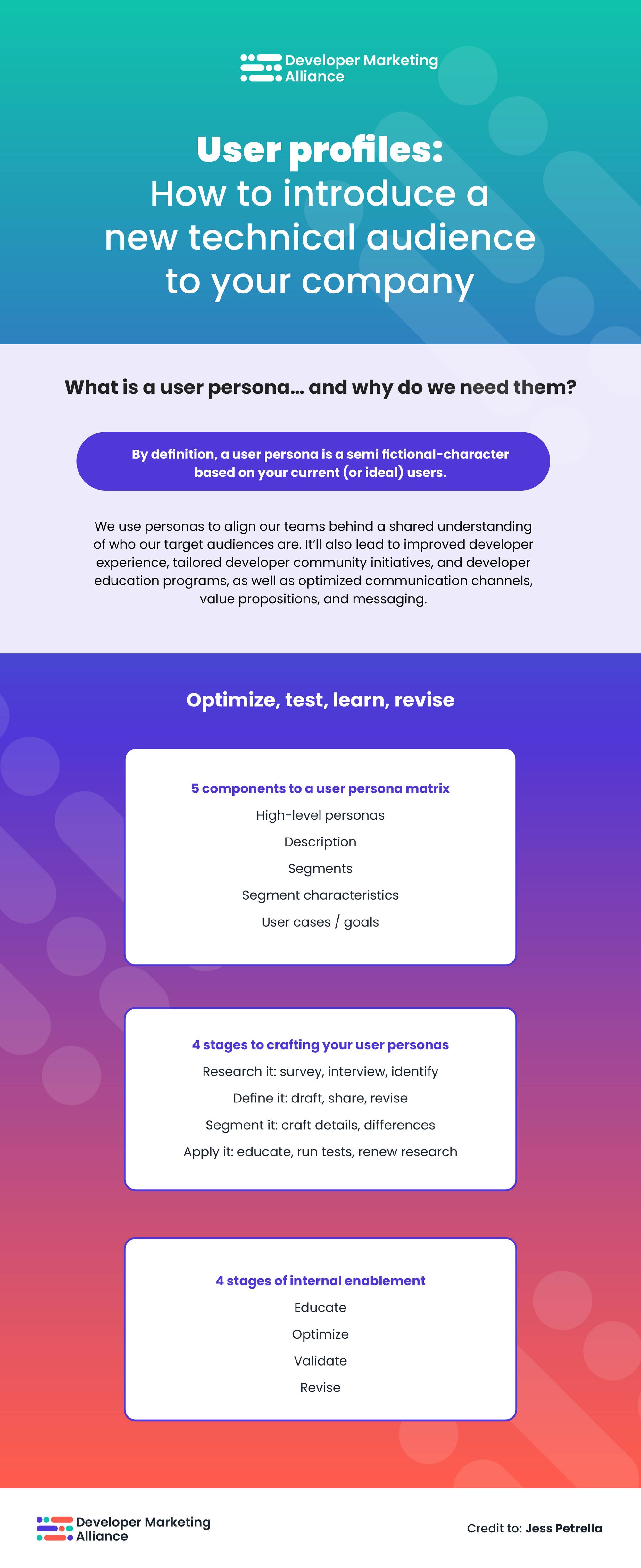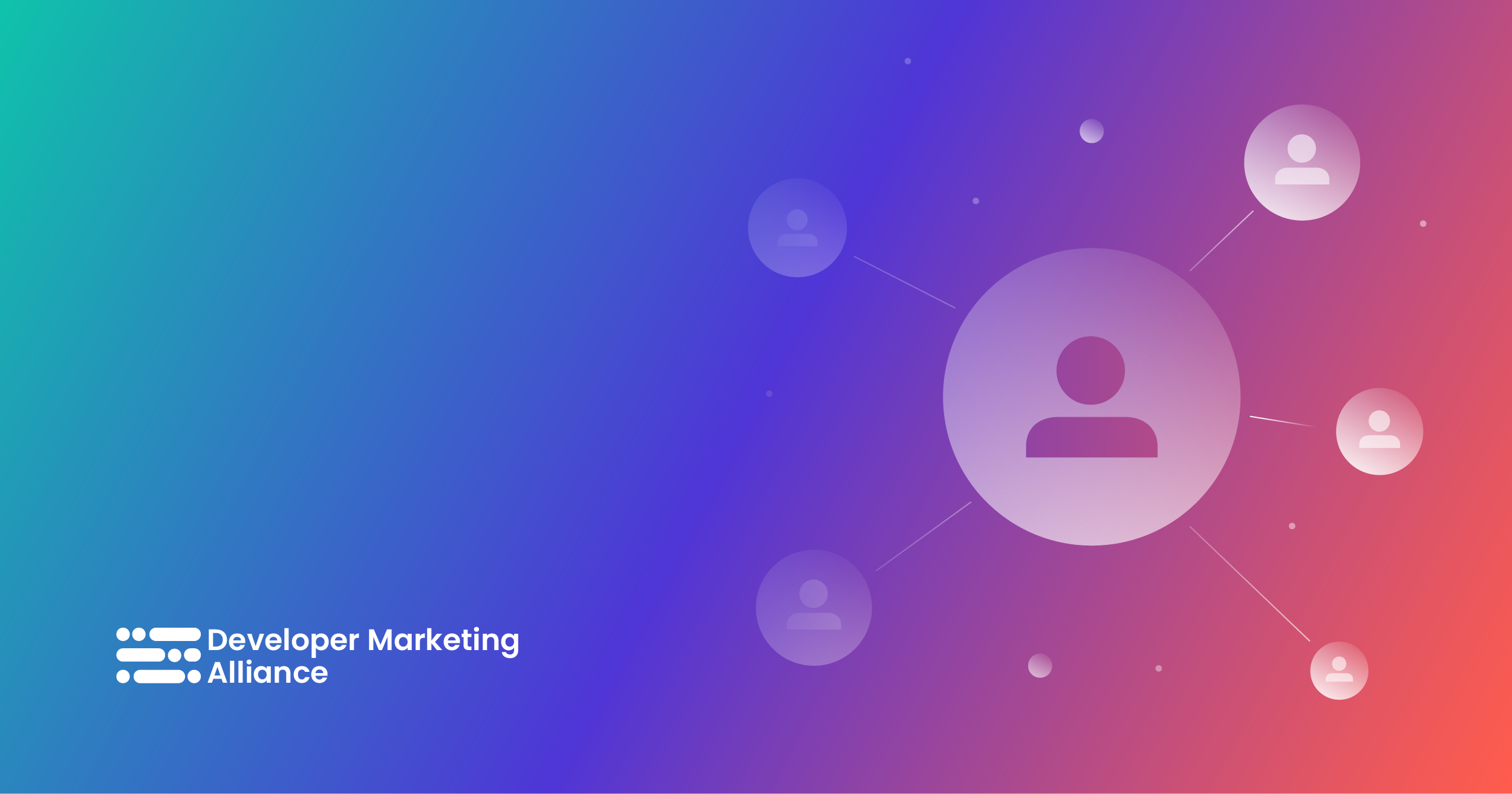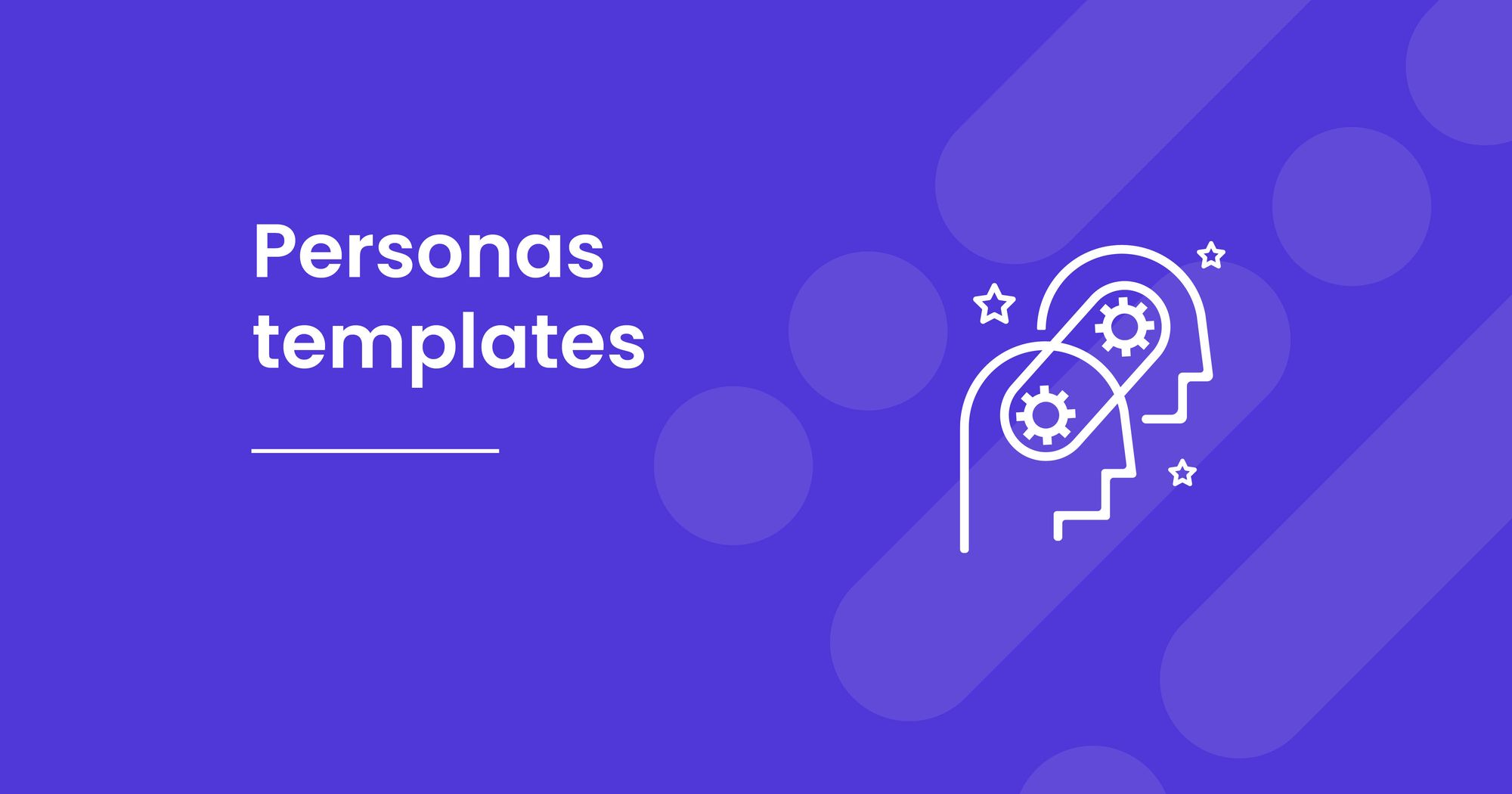This article is based on a talk from the Developer Marketing Summit March 2022.
My name is Jess Petrella, I’m the Group Product Marketing Manager at Unbounce. I have 10+ years of experience in SaaS, and you could say that I’m focused on product marketing all day, every day.
In this article, I’ll talk about introducing new technical audiences to your company by crafting well-researched personas that everyone can get behind.
Here's a sneak peek at how you can introduce a new technical audience to your company:

And here are our main talking points:
Let’s go ahead and dive in. 👇
What is a user persona… and why do we need them?
By definition, a user persona is a semi fictional-character based on your current (or ideal) users. Personas can typically be created by talking to users and segmenting them by their various data points.
In practice, we use personas to align our teams behind a shared understanding of who our target audiences are. It’ll also lead to improved developer experience, tailored developer community initiatives, and developer education programs, as well as optimized communication channels, value propositions, and messaging.
There's over 55 million ICT (information and communications technology) professionals working worldwide, and user personas help you focus on who your product’s for. If it can’t be for everyone, it's definitely for someone.
What does a technical persona look like?
This is an example of a high-level user persona matrix. In this example, we’re talking about a fictional company called Awesome SDK.
This is high-level and simplified, because when you're starting out with a new set of user personas, you want to go through a lot of validation work and to keep things simple. Then, give yourself, your team, and your company time to build and adapt stories from there.
Personas are your identified high-level users. Your segment refers to unique segments of users found within your high-level user category. Then, characteristics are unique characteristics of each user segment.
Lastly, use cases are unique for this segment and your product. Use cases can also be goals. Typically, for a more technical audience, a use case will help create a little bit more differentiation.
In practice, let's assume that AwesomeSDK is building out their personas for the first time and they've identified the solo developer, describing it as “solo likes to find projects of interest and work on them alone for personal gain”.
While they've talked to folks who use their product within this persona, they've defined two separate segments. One is a group of people that are income-motivated, and another is recognition-motivated. This means that their characteristics and use cases will differ.
For an income-motivated solo developer, their use case is ideal to build projects to make a passive income and gain promotions in their current job. A recognition-motivated segment within a solo developer persona, who’s a bit younger than the income-motivated segment, is looking to build projects to win awards and prizes and grow their resume.
How to create personas
The 4 stages to great personas
Now that we've gone through what a persona is, what we use them for, and what they look like, let’s talk about how we create them. There are four key stages:
- Research: This entails surveying, interviewing, identifying your early personas.
- Definition: This is where you're drafting, sharing with a small group, and revising.
- Segmentation: This stage involves crafting your segments and getting into the details and the differences of your personas.
- Application: Here, you go through the process of aligning your teams, validating your personas, and renewing your research.
#1 Conduct research
📋 Start with a survey
If you have users, survey them to easily categorize according to their responses.
The type of questions you'd want to ask would be characteristic questions like geography, age, coding languages, years of experience, job title, and team size. Then, focus on more value-based questions around use cases, goals, motivations, pain points, and desired outcomes.
While you're going through this survey process, it’s recommended to ask participants if they're open to being interviewed as a next step to prepare you for the next stage of your research.
Make it easy on yourself. Leverage tools like Typeform to create quick CSV outputs of responses, so that when you get into bucketing them, you're able to pull out responses.

🎙 Interview participants
At this stage, you have folks who’ve opted in, so you can send out an open call for interviews. Sharing incentives, such as gift cards, will greatly increase your bookings.
Dig into your value questions. Learning more about people’s unique goals and motivations, desires, outcomes, pain points and processes will be beneficial at this stage. Put your detective hat on and keep an eye out for patterns to note or common threads to pull on.
Make it easy on yourself when you're booking these interviews and use a tool like Calendly to organize your booking and increase your conversions.
🔎 Identify your key learnings
Now that you're loaded with your qualitative and quantitative research, it's time to distill your key learnings:
- What were your biggest buckets of characteristics?
- What were the leading use cases, goals, pain points, and desired outcomes?
- What connections did you make amongst groups of the above and why?
Make it easy on yourself and share your research with a team member. If you have a trusted or close collaborator you work with often, ask for feedback and perspectives.
#2 Define it
✍️ Draft your high-level personas
Once you've completed your research or your first round of research, you're digging into defining it.
At this stage, it's okay to make some bold assumptions, as you're trying to form your groups and buckets of personas.
🗣 Share your draft
Once you have this draft completed and you're feeling somewhat confident with it, you can start sharing it with your close team and selected key stakeholders.
This is not to inform them, get them on board, or to get buy-in, but you do want to start taking a temperature check on your initial draft. This’llhelp ensure that any biases or unfounded assumptions are being questioned from the start.
Make your feedback expectations clear at this stage with direct questions (i.e., is this how you see our users? In your opinion, what is off about how we're looking at our users and the persona buckets that we’ve created?).
You might get a different response from product and from marketing, but it'll illuminate a lot of interesting perspectives you can use or take into account as you're building your personas.
Another positive byproduct of sharing a draft with key stakeholders is that you may arrive at quicker buy-in by involving folks in your process.
🔧 Revise your draft
Now that you have more eyes on your initial research and high-level user personas, you should be able to confidently lock in your choices.
Keep in mind that, at this stage, nothing is set in stone and user personas can evolve over time.
The goal is to create a starting point.
#3 Segment it
🔬 Find the detail
With your high-level user personas in hand, it's time to zoom into them with finer detail.
You're asking yourself questions like, “is it possible to bucket each user interview into one of my identified user personas?”. If it is, then you have a signal of early success that your user personas are well defined.
How can you identify the commonalities in your use cases, motivations, values and characteristics of the people you interviewed? And can you find patterns?
👁 Find the difference
A big part of segmenting your users is identifying who they are, but it's just as important to determine who they aren't.
There should be clear differences between your segments. At minimum, their use cases should vary.
If not, your segments aren’t ready just yet. You may need to perform research to get to where you're going, and that's okay! You can go back to step one and talk to more customers or even go back to step two and share it again with your team.
#4 Apply it: the most important part!
Aligning your teams becomes one of the most important parts of building these personas.
Your teams want to be informed and that's something you should keep in mind when building these out. They want to be informed and understand how the personas will enrich their work.
The most impactful teams you can be talking to are: your DevRel (developer relations) and support teams. Personas can support their playbooks, their targeted outreach, their developer experience and everything they build into it.

Some of the metrics they can help move the needle with are engagement, reply rate, satisfaction score, and time-to-ticket resolution.
Detailed personas can also help the developer community team tailor content, dig into specific problem solving, and tailor tone, and messaging.
Some metrics you can move the needle on with more targeted communications would be: engagement levels, number of new advocates, and number of new active members.
Your PMM teams, marketing and product teams are also very interested and close to user personas. They can use them to reach their content, targeted comms, and message-market fit.
Some metrics they would be interested in are: adoption rate, demo conversions, number of feedback, input, and activation metrics.
Enablement can exist on a cycle. Starting with education, moving into the optimized stage, into validation, and revision. Every revision phase restarts the education enablement cycle.
When educating your team, you have your packaged user personas along with your research reports, recorded interviews, and survey data.
At this stage, it's important to show your work as your teams will want to dig into your research and hear from your recorded interviews and customers.
The next stage will be to share this with your team. Book info sessions with your teams and individuals to start. Aim for alignment, buy-in and enthusiasm before bringing this out to the broader company.
It's also important to listen. Hear your teams’ and your stakeholders' perspectives and ideas. Take all expertise and questions into account.
Join forces with your team and be clear about your intentions for how identifying personas, segments, and data can enable the team specifically. Focus on the metrics and on the output and enablement that can be created per team and per specific team's needs.
Finally, become a stakeholder and an ally. Once you've shared, enabled and listened to your team, the goal is that user personas should enable comms, content, and strategies in many areas of the dev experience.
As the champion of these user personas, you should be open to supporting future research, creating revisions, and taking team asks. You want to be seen as the expert because you’re the person doing the research and bringing this into your team.
The more questions the better, as it means your teams are engaged, enthusiastic, and they see the value in what you're creating.
Once you've enabled and educated your teams, the cycle goes on to optimize, validate, and revise.
Optimizing means you would start small with the intention of learning. You can modify language, content and comms to speak clearly to your primary segments too.
You’ddo that in a test atmosphere in order to validate. You would test something small, like a blog post, a community engagement post, an activation email, an A/B test key, a key page, and then you look for lift in the key metrics for that channel or for that team.
Once you’ve started to validate things, you can then revise them as needed. A big part of modifying and improving your user personas is to listen. Be open minded to prospective changes in information and additional data.
Major and minor revisions to your user persona matrix should restart the enablement cycle.
To recap
We talked through the five components to a user persona matrix, which are: high-level personas, description, segments, segment characteristics, and use cases and goals.
The four stages for crafting your user personas, which are: research, definition, creating a draft, sharing revisions, segmenting it, getting into the details and the differences, and applying it through education, running tests, and renewing research.
Then finally, we discussed the four stages of internal enablement, which are: educate, optimize, validate, and revise and repeat as needed.
Need help crafting your technical personas? Our persona templates are the perfect jumping-off point to portraying your target audience in the most accurate way.






